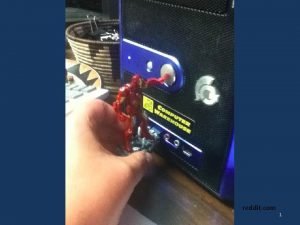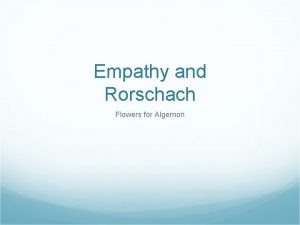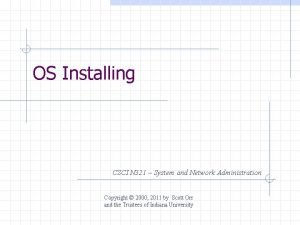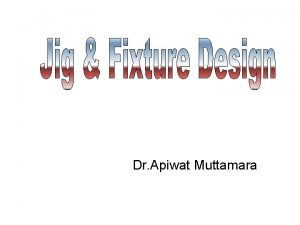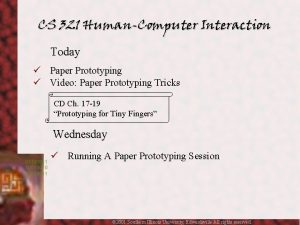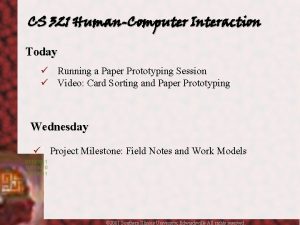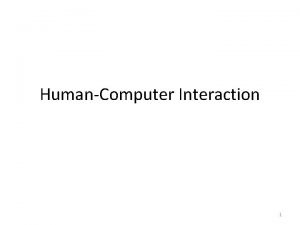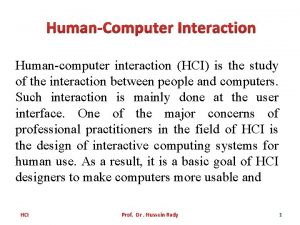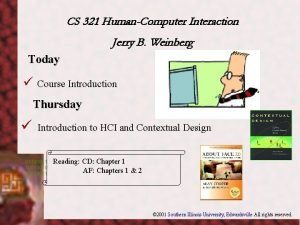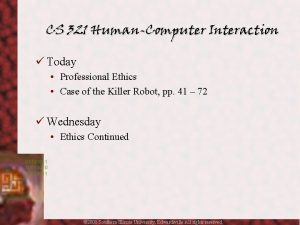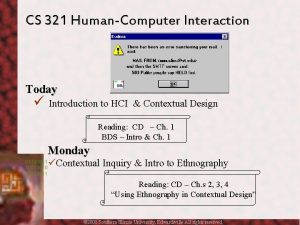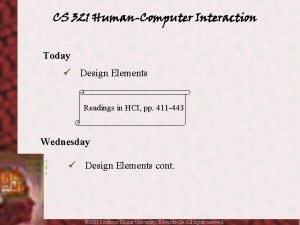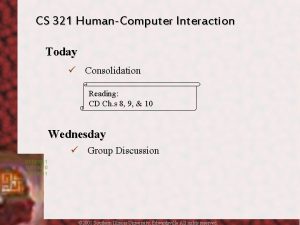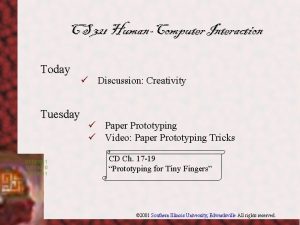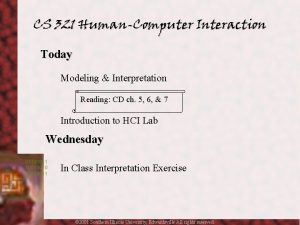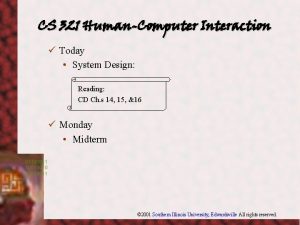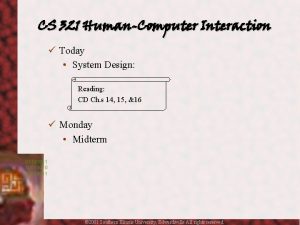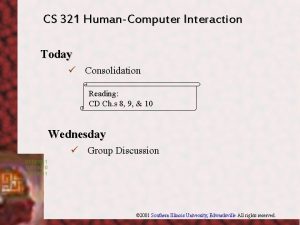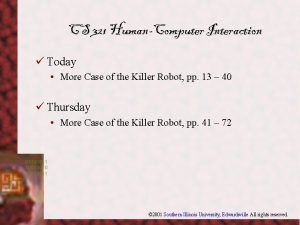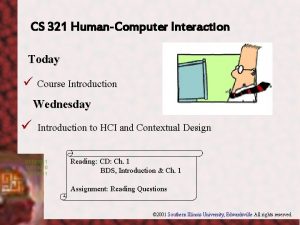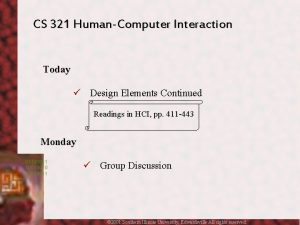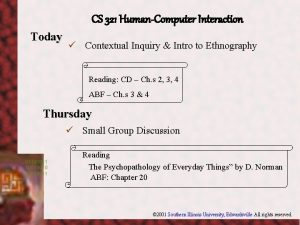CS 321 HumanComputer Interaction Today Paper Prototyping Video




















- Slides: 20

CS 321 Human-Computer Interaction Today ü Paper Prototyping ü Video: Paper Prototyping Tricks CD Ch. 17 -19 “Prototyping for Tiny Fingers” Tuesday How to run a Paper Prototyping Session © 2001 Southern Illinois University, Edwardsville All rights reserved.

Prototyping Ø Definition of a prototype Ø A model on which something is based. Ø A reasonably close facsimile of the final product © 2001 Southern Illinois University, Edwardsville All rights reserved.

Why Prototype? Ø A tool to validate the user interface is usable and reveals the structure clearly Ø Provides a structure that fits the user’s work model Ø A tool for communication between the design team and the user Ø User’s vocabulary Ø User becomes a co-designer Ø Iterative refinement © 2001 Southern Illinois University, Edwardsville All rights reserved.

Prototyping Medium Ø High Fidelity Prototypes Ø A. K. A. Hi-fi, Rapid Prototyping Tools Ø Examples Ø Visual Basic Ø HTML and scripting (ASP, Java) Ø Director Ø Powerbuilder Ø Hypercard Ø Black Box Coding © 2001 Southern Illinois University, Edwardsville All rights reserved.

Prototyping Medium Ø Low Fidelity Prototypes Ø A. K. A. Lo-fi, Paper Prototyping Ø Examples Ø Paper Ø Post-it’s Ø Tape Ø Glue Ø Play Computer © 2001 Southern Illinois University, Edwardsville All rights reserved.

Paper Prototyping ü What Is Paper Prototyping? • Early design tool. • Used to test a programs usability. • Use simple office materials to create a paper based simulation of an interface. • Rough draft thus open to correction and errors. • Lo-fidelity. © 2001 Southern Illinois University, Edwardsville All rights reserved.

Paper Prototype Kit ü Useful things to have in your kit • Post-it notes (multiple sizes) • Post-it tape • Index cards • Sturdy Paper / Index Folders • Transparencies • Pointer or pencil • Hardware Props • Scissors, straight edge © 2001 Southern Illinois University, Edwardsville All rights reserved.

Lo-fi vs. Hi-fi Score Board Ø Time to Build Ø Lo-fi: Ø Quick to build Ø 2 to 3 hours depending on number of screens and complexity Ø Hi-fi: Ø Screen quick, but black boxing can take a significant time commitment Ø 2 to 3 weeks depending on complexity and team size © 2001 Southern Illinois University, Edwardsville All rights reserved.

Lo-fi vs. Hi-fi Score Board Ø Quality of Feedback Ø Lo-fi: Ø Maintains focus on work structure and interface elements Ø Hi-fi: Ø Reviewers tend to focus on finishing touch issues ØFonts, alignment, colors © 2001 Southern Illinois University, Edwardsville All rights reserved.

Lo-fi vs. Hi-fi Score Board Ø Changeability Ø Lo-fi: Ø Invites change Ø Because it is easy to change, changes can be made on the fly Ø Hi-fi: Ø Developers resistant to change Ø Too much time and effort invested – feeling of ownership © 2001 Southern Illinois University, Edwardsville All rights reserved.

Lo-fi vs. Hi-fi Score Board Ø Feature Creep (Creap) Ø Lo-fi: Ø Gives the impression that development is still in design Ø Hi-fi: Ø Gives the false impression of being done © 2001 Southern Illinois University, Edwardsville All rights reserved.

Lo-fi vs. Hi-fi Score Board Ø Program bugs Ø Lo-fi: Ø No program bugs – no problem Ø Hi-fi: Ø Single bug can bring prototype session to a halt (or kill a project) Ø Users as Co-Designers Ø Lo-fi: Ø Invites the user to provide suggestions Ø Hi-fi: Ø Gives the impression of being done © 2001 Southern Illinois University, Edwardsville All rights reserved.

Lo-fi vs. Hi-fi Score Board Ø Timing Studies Ø Lo-fi: Ø Cannot be done Ø Hi-fi: Ø Can be done Ø Animation Ø Lo-fi: Ø Cannot be done Ø Hi-fi: Ø Can be done, but sometimes complicated © 2001 Southern Illinois University, Edwardsville All rights reserved.

And the Winner Is. . . Lo-fi! Final Score Lo-fi Hi-fi Score Board © 2001 Southern Illinois University, Edwardsville All rights reserved.

How do you make a paper prototype? © 2001 Southern Illinois University, Edwardsville All rights reserved.

How do you make a paper prototype? ü Paper Prototype Tricks Video © 2001 Southern Illinois University, Edwardsville All rights reserved.

What about small screens? © 2001 Southern Illinois University, Edwardsville All rights reserved.

What about small screens? © 2001 Southern Illinois University, Edwardsville All rights reserved.

What about small screens? © 2001 Southern Illinois University, Edwardsville All rights reserved.

What about small screens? Include both if they are designed to work together © 2001 Southern Illinois University, Edwardsville All rights reserved.
 Rapid prototyping video
Rapid prototyping video Galton details
Galton details For todays meeting
For todays meeting Today's lesson or today lesson
Today's lesson or today lesson We are going today
We are going today Today's lesson or today lesson
Today's lesson or today lesson Meeting objective
Meeting objective The fed today video questions answers
The fed today video questions answers Algernon definition
Algernon definition Video.search.yahoo.com
Video.search.yahoo.com The frame size of a video refers to the video’s
The frame size of a video refers to the video’s Yandex ru video search text
Yandex ru video search text Video.search.yahoo.com
Video.search.yahoo.com General paper questions
General paper questions Aice english paper 2
Aice english paper 2 Edel 321
Edel 321 Ics-321
Ics-321 Management myths in software engineering
Management myths in software engineering Evard's life cycle
Evard's life cycle Eccentric leveling lugs
Eccentric leveling lugs Apokalypsis 321
Apokalypsis 321
